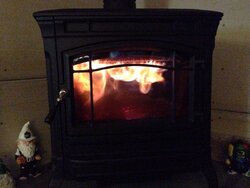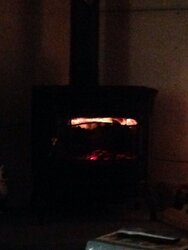Yesterday I reloaded the lukewarm stove. Little coals were remaining but enough to restart.
In a short time I had good flames, not only leaking from the logs but also appearing round the burn tubes.
Now I said to my son, "as there is a nice blanket af fire in the ceiling of the stove, all smoke will burn". We went outside and there was no smoke.
So although the stovetop bearly read 200 I turned the air down to 1/2 and the fire slowed down a bit, but still seamed to burn clean and grow very slowly.
I also reason that when I turn down primary air I reduce outgassing, so less burnable gases (creosote forming) , I move air injection from bottom of the fire to the top, so there is more air available for secondaray burning.
It took over an hour to get to 400. This is an Oslo so it takes long but can be done in 30 minutes with softwood and a lot of kindling. After 5 hours all wood consumed and enough coals to restart. I han the stove half full.
I'm aiming at a few effects here:
1. Reduce the amount of heat loss through the chimney at startup so more heat for us
2. Less risk, when you leave the air open and forget you could be in for a surprise
3. It seems this way the fire eats its way through the firebox instead of starting everywhere at the same time. I notice completely untouched wood in the back after 90 minutes.
That said, I realise that my stack will take a long time to heat up and although the wood is kiln dried and the fire seems smokeless I will probably take a risk here?
In a short time I had good flames, not only leaking from the logs but also appearing round the burn tubes.
Now I said to my son, "as there is a nice blanket af fire in the ceiling of the stove, all smoke will burn". We went outside and there was no smoke.
So although the stovetop bearly read 200 I turned the air down to 1/2 and the fire slowed down a bit, but still seamed to burn clean and grow very slowly.
I also reason that when I turn down primary air I reduce outgassing, so less burnable gases (creosote forming) , I move air injection from bottom of the fire to the top, so there is more air available for secondaray burning.
It took over an hour to get to 400. This is an Oslo so it takes long but can be done in 30 minutes with softwood and a lot of kindling. After 5 hours all wood consumed and enough coals to restart. I han the stove half full.
I'm aiming at a few effects here:
1. Reduce the amount of heat loss through the chimney at startup so more heat for us
2. Less risk, when you leave the air open and forget you could be in for a surprise
3. It seems this way the fire eats its way through the firebox instead of starting everywhere at the same time. I notice completely untouched wood in the back after 90 minutes.
That said, I realise that my stack will take a long time to heat up and although the wood is kiln dried and the fire seems smokeless I will probably take a risk here?



